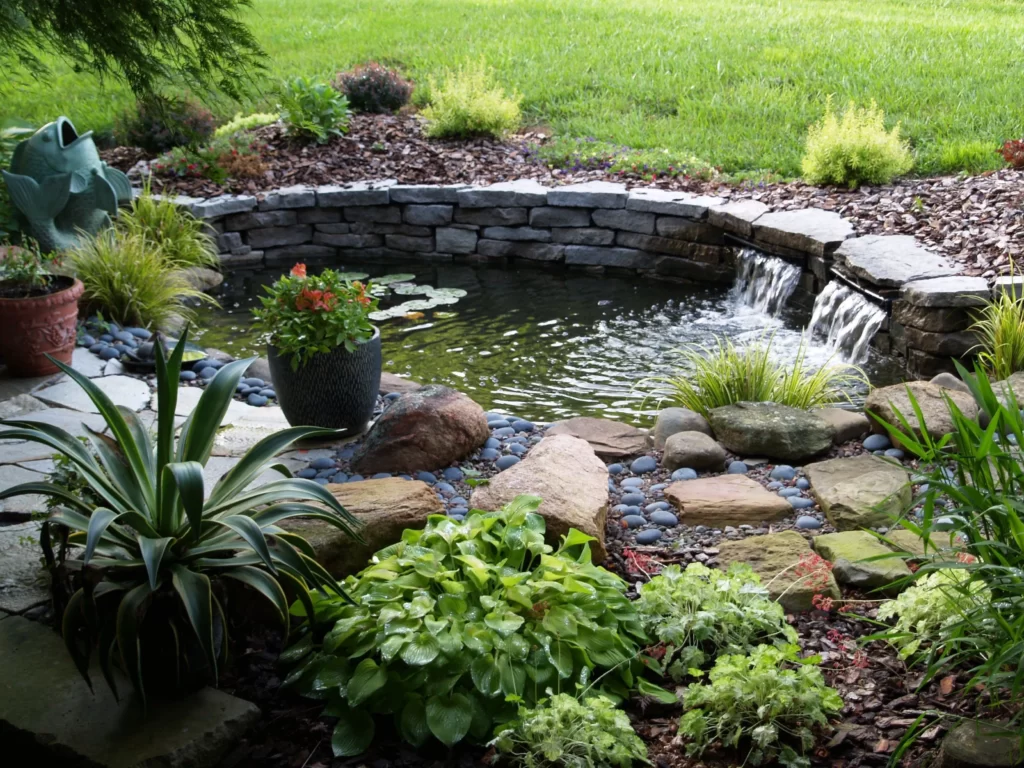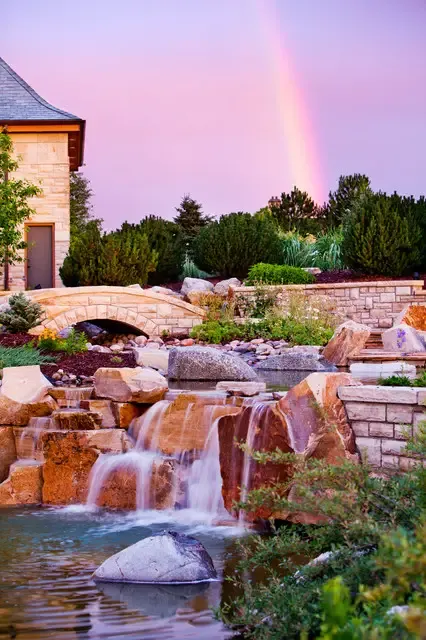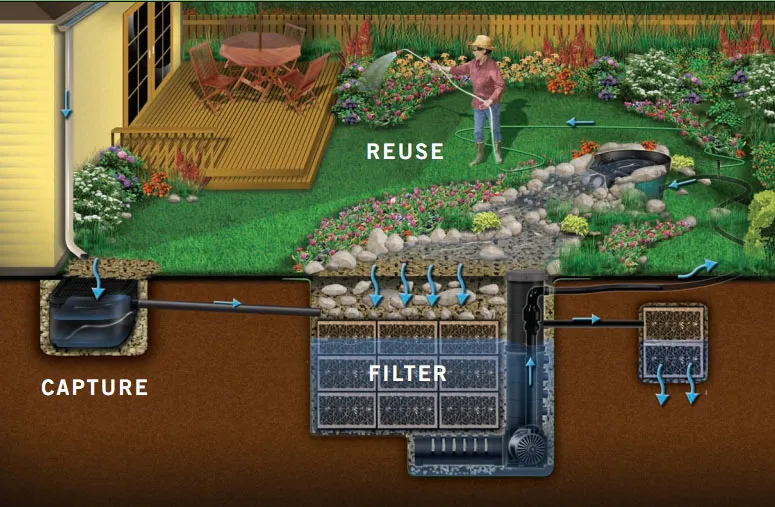If you want to know about the landscape garden or Introduction of landscaping and its role or terminology used in landscape, please click the link.
Introduction
Water features are decorative elements in landscape design that incorporate water as a central feature. Water features can come in a variety of forms, including fountains, ponds, waterfalls, and streams. Water features can be designed for aesthetic value, functionality, or to provide a habitat for aquatic wildlife.

Importance of water features in landscape design
Water features are important in landscape design as they can create a sense of tranquility, movement, and a connection with nature. Water features can also improve air quality, create a microclimate, and enhance the overall aesthetic value of a property. Water features can also be used to create a focal point, to mask noise pollution, and to provide a cooling effect during hot weather.
1) Types of Water Features
Water features come in a variety of types, and each type can bring a unique look and feel to a landscape design. Here are some common types of water features:
i) Fountains

Fountains are a popular water feature in landscape design. They come in many different styles, from classic tiered fountains to modern abstract designs.
- Fountains can be designed to suit any size of outdoor space and can be made from various materials, such as stone, metal, or concrete.
- Fountains can also be equipped with lighting systems that provide a stunning visual display at night.
ii) Ponds and water gardens

Ponds and water gardens are another popular water feature in landscape design. Ponds can range from small backyard water gardens to large koi ponds. Water gardens incorporate aquatic plants such as lilies and lotuses that add color and texture to the pond. Ponds can also be home to fish and other aquatic life.
- Ponds and water gardens require careful design and maintenance, including consideration for the placement, size, and materials used in the construction.
iii) Waterfalls and streams

Waterfalls and streams are natural-looking water features that can add an element of tranquility to a landscape design. Waterfalls can be designed to be large and dramatic or small and subtle.
- Streams can be created to mimic a natural waterway and can be integrated into the surrounding landscape by using natural stone and planting native vegetation.
- Waterfalls and streams can also be used to create an ecosystem, attracting wildlife such as birds and insects.
iv) Swimming pools

Swimming pools are a popular water feature in landscape design and can be designed to suit any size and style of property.
- Swimming pools can be designed in many shapes and sizes, from a classic rectangular shape to a more modern, free-form design.
- Swimming pools can also be equipped with a variety of features, such as waterfalls, slides, and hot tubs.
- Swimming pools require careful design and maintenance, including consideration for the placement, materials, and the surrounding landscape.
v) Rainwater harvesting systems

Rainwater harvesting systems are becoming an increasingly popular water feature in landscape design. They are designed to collect and store rainwater for later use in irrigation and landscaping.
These systems can be designed to be both functional and aesthetic, with features such as fountains and waterfalls that add a sense of tranquility to the landscape. Rainwater harvesting systems can also be incorporated into larger, sustainable landscape designs that focus on reducing water usage and promoting environmental sustainability.
2) Design Considerations
When incorporating water features into a landscape design, there are several important design considerations that need to be taken into account. Here are some key design considerations for water features:
i) Site analysis and water source
Before designing a water feature, it’s important to conduct a site analysis to determine the suitability of the area. The analysis should include factors such as topography, soil type, and drainage.
It’s also important to consider the water source, whether it’s a natural spring, municipal water supply, or a recycled water system.
ii) Integration with the overall landscape design
A water feature should complement the overall landscape design and should not be an afterthought. It’s important to consider the style, colors, and materials used in the design of the water feature and how they integrate with the surrounding landscape.
The water feature should also be appropriately scaled for the size of the property and the other elements of the landscape design.
iii) Safety and maintenance considerations
Water features require regular maintenance to keep them clean and functioning properly. It’s important to consider the safety aspects of the water feature, such as the depth of the pond or pool, the placement of rocks and other features, and the use of non-slip surfaces.
It’s also important to consider the maintenance requirements of the water feature, such as cleaning, algae control, and winterization.
iv) Environmental impact and sustainability
Water features can have a significant impact on the environment, including water usage, wildlife habitat, and energy consumption. It’s important to consider the environmental impact of the water feature and to design it with sustainability in mind.
This could include using recycled water, planting native vegetation, and incorporating features such as rainwater harvesting systems.
v) Cost and budget considerations
Water features can vary significantly in cost, depending on the size, materials, and complexity of the design. It’s important to consider the budget for the water feature, including the cost of installation and ongoing maintenance.
It’s also important to consider the long-term value of the water feature, including its impact on property value and the overall enjoyment of the outdoor space.
3) Benefits of Water Features
Water features can offer a range of benefits when incorporated into a landscape design. Here are some of the key benefits of water features:
i) Aesthetic value and visual appeal
Water features can add significant aesthetic value to a landscape design. The reflections of the water, the movement of the surface, and the colors and textures of surrounding materials can all create a visually appealing experience. The design of the water feature should complement the surrounding landscape and provide a focal point for the eye.
ii) Sound and sensory experience
Water features can provide a soothing and relaxing sensory experience. The sound of running water can create a calming atmosphere, while the texture of the water can provide a tactile experience. The water feature can also attract birds and other wildlife, creating a multisensory experience in the outdoor space.
iii) Wildlife habitat and biodiversity
Water features can provide a habitat for various wildlife species, such as birds, frogs, and fish. The use of native plants and materials in the water feature can also promote biodiversity in the surrounding landscape. It’s important to consider the ecological impact of the water feature and to design it in a way that promotes the health of the ecosystem.
iv) Water conservation and irrigation
Water features can also play a role in water conservation and irrigation. By using recycled water or collecting rainwater, water features can reduce the demand for municipal water supplies. The water feature can also be designed to irrigate surrounding plants and vegetation, reducing the need for additional irrigation systems.
v) Increased property value
Water features can add significant value to a property, both in terms of aesthetic value and functionality. A well-designed water feature can create a sense of luxury and sophistication, increasing the perceived value of the property.
The water feature can also be designed to provide additional functionality, such as a swimming pool for exercise or a rainwater harvesting system for sustainability.
Incorporating water features into a landscape design can offer a range of benefits for both the environment and those who enjoy the space. From increasing visual appeal to providing a sustainable source of water, water features are a valuable addition to any landscape design.
4) Examples of Water Features in Landscape Design
Water features can be incorporated into a landscape design in a variety of ways. Here are some examples of different types of water features that can be used in landscape design:
i) Residential landscaping examples
Water features are a popular addition to many residential landscapes. Examples of water features in residential landscaping include small ponds or water gardens, fountains, and backyard swimming pools.
- These water features can enhance the aesthetic appeal of the outdoor space and provide a relaxing environment for homeowners.
ii) Commercial and public space examples
Water features can also be used in commercial and public spaces, such as office buildings, shopping centers, and public parks. Examples of water features in commercial and public spaces include large fountains, reflecting pools, and interactive water features.
- These water features can serve as a focal point for the outdoor space and create a visually appealing environment for visitors.
iii) Historical and cultural examples
Water features have been used in landscape design for centuries and have played an important role in many cultures. Examples of historical and cultural water features include the Alhambra’s Court of the Lions in Spain, the reflecting pool at the Taj Mahal in India, and the fountains at Versailles in France.
- These water features often have significant cultural and historical significance, and are valued for their aesthetic and symbolic value.
iv) Contemporary and innovative examples
Contemporary and innovative water features are often designed with unique and creative features that push the boundaries of traditional landscape design. Examples of contemporary and innovative water features include interactive water walls, floating pools, and misting fountains.
- These water features are often designed to create a one-of-a-kind experience for visitors and showcase the latest in technology and design.
v) Before and after transformations
Water features can also be used in before and after transformations to showcase the impact of a well-designed outdoor space. Examples of before and after transformations include the addition of a small pond or fountain to a backyard, or the transformation of a commercial space into an outdoor oasis with multiple water features.
- These examples can showcase the dramatic impact that water features can have on the visual appeal and functionality of a space.
5) Conclusion
Incorporating water features into a landscape design can provide a range of benefits, from visual appeal to sustainable water practices. There are many different types of water features that can be used, from fountains to swimming pools to rainwater harvesting systems, and each one can be designed to fit into the overall landscape design.
By considering the site, water source, and other design considerations, water features can be integrated into a landscape in a way that is both beautiful and functional.
Whether you are designing a residential or commercial landscape, water features can be a valuable addition that enhances the overall design and provides a range of benefits for both people and the environment.